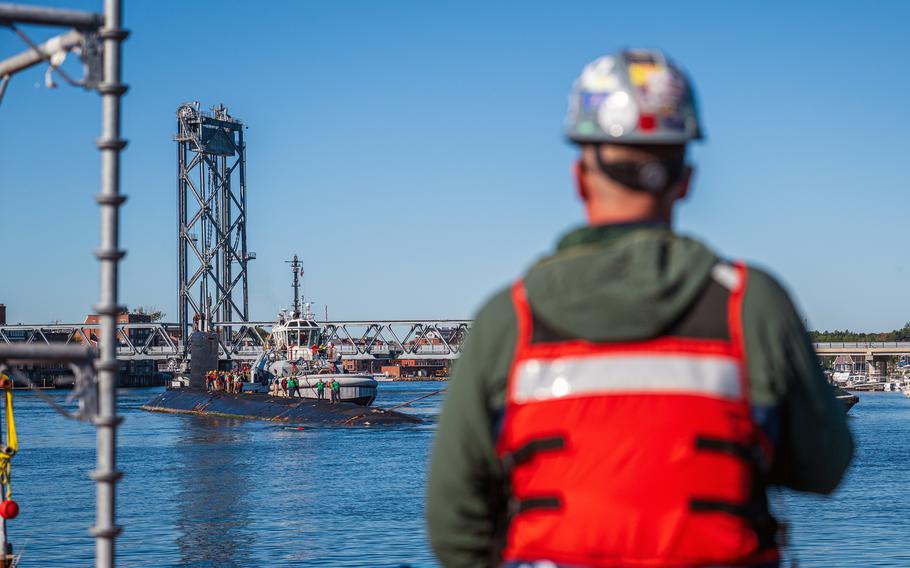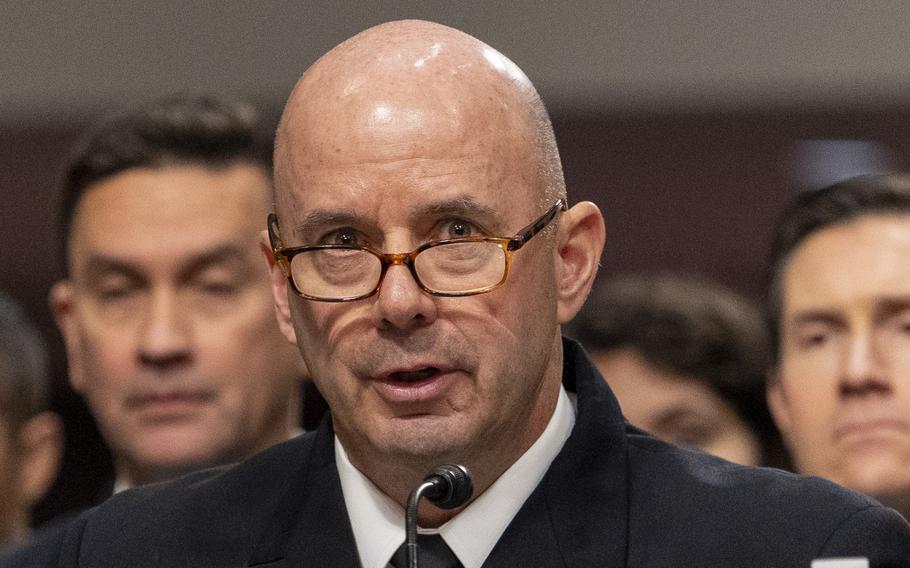
The USS Washington, a Virginia-class, nuclear-powered submarine, arrives at Portsmouth Naval Shipyard in Maine in September 2024 for a scheduled maintenance. (Branden Bourque/U.S. Navy)
WASHINGTON — At least 10 workers were fired from Portsmouth Naval Shipyard in Maine this week, a day after a top Navy admiral told lawmakers that the service’s shipyard workforce is exempt from a Defense Department-wide probationary employee purge.
All 10 were entry-level probationary workers in administrative positions. Of those, four were fired for performance issues. The other six were let go based solely on their probationary status, according to the chapter president of a union that represents more than 500 workers at the public Navy shipyard.
“From what we were told, the Navy thought those positions were the least impactful to the mission,” said Bill Webber, president of the American Federation of Government Employees Local 2024 chapter. “I argue … every position in the shipyard has purpose.”
The firings occurred the same week that Adm. James Kilby, the Navy’s vice chief of operations, told the Senate Armed Services Committee that probationary shipyard workers would be exempt from the Pentagon’s first wave of workforce cuts.
“We are trying to shape this in a manner that allows us to continue the most important work as we work through guidance from the [Trump] administration,” Kilby told senators Wednesday during an update on the status of the force.
The Defense Department on March 10 began cutting its civilian workforce, with the goal of immediately purging 5,400 probationary workers. The Pentagon plans to slash its workforce by up to 8%, which could total more than 70,000 federal workers.
Lawmakers and unions have urged the Navy to exempt its four public shipyards — Portsmouth Naval Shipyard, Norfolk Naval Shipyard in Virginia, Puget Sound Naval Shipyard in Washington, and Pearl Harbor Naval Shipyard in Hawaii — from the Pentagon’s civilian workforce purge. The shipyards are responsible for maintaining the Navy’s nuclear-powered fleet of submarines and aircraft carriers.
“As you are no doubt aware, the men and women who work at our public shipyards are critical members of our defense industrial base, without whom the ability to repair, retrofit and refuel our country’s submarines would be in jeopardy,” Sens. Jeanne Shaheen, D-N.H., and Susan Collins, R-Maine, wrote to the Navy in a letter dated Feb. 11.
Following Kilby’s statement Wednesday about the shipyard exemption, Shaheen said: “More uncertainty and a lack of guidance from the administration jeopardizes our national defense and preparedness. If [President Donald Trump] cares about strengthening shipbuilding as much as he claims, he’d exempt workers at Portsmouth Naval Shipyard — whose jobs are vital to our national security — from reckless, indiscriminate cuts to the civilian workforce.”

Adm. James Kilby, vice chief of naval operations, testifies March 12, 2025, during a meeting of the Senate Armed Services Committee. (Eric Kayne/Stars and Stripes)
Portsmouth Naval Shipyard employs nearly 8,000 civilian workers, which includes police, secretaries and other administrative workers, and training instructors, as well as a variety of industrial workers. It has a workforce shortage of more than 550 people, Shaheen said.
The Navy was working with the Defense Department and Office of Personnel Management to identify critical functions at the shipyards and offer exemptions to workforce cuts, according to a letter dated Feb. 28 and signed by Terence Emmert, acting Navy secretary.
“The [Department of the Navy] is committed to carry out workforce shaping in a manner that preserves lethality and readiness, while advancing the administration’s imperatives of reduction and cost savings,” Emmert wrote.
Webber said he expects at least six of the 10 fired employees to be reinstated following a Thursday ruling from a federal judge that ordered the immediate rehiring of fired probationary workers across the federal government. Judge William Alsup ruled the OPM and its acting director, Charles Ezell, acted unlawfully when they ordered mass job terminations of the new workers.
“We need them. We would not have had to fill these positions in the first place if they were not needed,” Webber said.
He said he hopes the union can fight for performance-based firings of probationary workers to be conducted on a case-by-case basis. Ultimately, he would like to see all 10 employees rehired.
The Navy on Friday referred questions about the shipyard firings and potential rehiring to Kilby’s testimony. A Navy official said the service is working through the implementation of the DOD workforce guidance and the court ruling.
The shipyard workers and civilian mariners for the Military Sealift Command are exempt from the federal hiring freeze, Kilby told senators Wednesday. The exemption will allow the shipyards to continue recruiting new workers to fill gaps that pre-date directives to trim the workforce. Labor shortages at Navy shipyards has been a yearslong struggle that officials have attributed to low wages.
Webber said, as of Friday, the union and the Portsmouth shipyard had not received any guidance from the Navy.
“All we have right now is the admiral’s word,” he said.
Workers at the Maine-based shipyard, Webber said, have been “on eggshells” since the workforce purge was announced. A resignation buyout offered in February was accepted by 120 workers at the site. Of those, 40 spots are now unfilled. The other 80 spots, Webber said, will be vacated starting next week.
“Our people just want to go back to work and do the mission that we do — modernize submarines and get them back to the fleet, on-cost and on-budget,” he said. “But we can’t afford a reduction of force or we won’t be able to meet the Navy’s mission.”